 |
| The blackboard on 6 Sept |
The blackboard in the Prep Room has finally been put to good use. Thin white spidery legs crawl out from the centre of "ART" to diverse points, outlining the many aspects of art and the art industry - curated in the most haphazard way, chalked down as these came up in discussion, and squeezed in wherever there was space.
So what were the themes and problematic
areas that we came across? I’ll try here to further break them down and group
them in categories, drawing some connections within each and across categories.
These categories are of course not mutually exclusive, with some points capable
of straddling two or more categories quite comfortably.
Art
as commodity
Fetish(isation)
Self-indulgence
Sensationalism
Potentially addictive and divisive
Lucrative market
Objectification
Escapism
Branding/marketing
Potentially nostalgic
Curiousity
Globalisation – circulation through
networks
Commodity here is meant to be more than
just the circulation of art as goods in the capitalist market. It is meant also
to highlight the consumption of art. With the exception of performance art (On
second thought, maybe not – it is bounded by time.), art is often bounded, and
it is this boundedness that makes it easy to consume, to form relationships
between viewer and object for the majority of those who encounter it. This
poses a few questions: What about a commodity that makes it easily consumable?
What ignites our interest in it?
Art
as commentary
Moral judgement
Connotative taboo – not socially acceptable
Potentially slippery
Heteronormativity – internalising the male
gaze
Site of resistance – as a political space
Critique
Social activism
Cannot un-see
-> Hero and victim – symbolic violence
-> Can you be desensitised?
-> Challenge moral judgement (subversive)
Not all art is explicit on this.
Nonetheless, it is hard, dare I say even impossible?, to create art with no
narrative. Narratives can consist of anything, be that of an ideal state, a
perceived reality or a social commentary. From our trip to Bandung, we have
seen artists as activists. Then there are also artists who occupy that slippery
state between the acceptable and unacceptable, as Nobuyoshi Araki does with his
pornographic photographs. There are also artists who challenge categories and
definitions, as Morimura Yasumasa does with ideas of gender. This appropriation
artist, with his work Vemeer Study:
Looking Back (Mirror), challenges the male gaze and heteronormativity found
historically in European art. But there are issues that arise from this – the
symbolic violence that art wrought on its subject by objectifying it. Just as
it can make its subject the hero, it can also potentially make it the victim. As
we look at Vemeer Study, Morimura’s
painful reconstruction from a Japanese male to a Caucasian female is a heroic
sacrifice to comment on heteronormativity, but a sacrifice nonetheless that
reminds us of his veiled victimhood. And how about art that seeks to be
subversive? Does it also desensitise?
Art
as production
Accidental
Mixed-media
Meticulous sense of detail
Perverse in productive sense
Aesthetic conventions
-> What is the ideal?
-> Fabricated
-> So real it becomes fantasy? – hyperreal, transcendental
-> Schema theory
Technology of empire and nation – exoticism
Audience participation
Educational tool
Can we separate the person from the act?
Art is the result of the artist’s work,
which does not need elaborating. But art is also the production of meaning on
the part of the artist who created it, the curators who exhibit it, and the
viewers who consume it. It is also part of the production of power,
representation and boundaries, and the production of history and identity.
Having said that, let me here move on to
the other half of the blackboard and introduce Poon Buck Seng – the artist,
curator, conservator and activist we have chosen to exhibit in January. An
archetypal figure, Poon is the ideal subject. But is he only really so from the
result of engineering on the curator’s part? The qualities that we have
selected and presented combine to make him a curatorial darling. He is transgressive,
potentially aspiring, an eccentric, a provocateur, eloquent, works the
bureaucracy, evades authorities, garners sympathy, dramatic, brazen and daring,
meticulous, socially conscious of the contemporary, passionate, a persistent
collector, occupies spaces in a temporal manner, itinerant, an urbanist,
obsessive, sentimental, a taste-maker, selective, a pragmatist, an idealist, and
insist on authorial recognition. He is as much a curatorial fiction as he is
real, our discussion laying bare the hidden hand of the curator in making the
artist.


